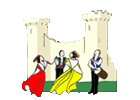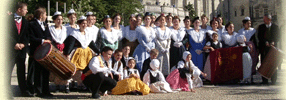|
Dances
Our Provencal dances are classified in different categories, depending on their origins :
-
The military dances -
The military dances , very athletic (First danced my the sailors during contests between the crews) are performed today by the most agile dancers dressed as «farandoleur» (or «farandoleuse» for the girls) (white pants or skirt, white shirt, red «taillole»(belt)) and are the object of contests between the different dance groups (for the dance called «farandole») or exams to obtain the title of «Prevôt de danse», assistant dancing master (dance called «gavotte») and then «Maître de danse» (Master of dance when the dancer is found able to dance correctely the «gigue»).
Those titles are directly inspired from the ranks in fencing!
The steps, very technical, are similar to classical dance steps.
-
The parlour dances -
|
|
Glissades and spinning steps, the parlour dances are often danced two by two. |
The parlour dances (that also took place at king Louis the XVI th court) admit glides, chasses, but very few jumping steps : Volte , Mazurka, … Less technical, they emphasize the choreographies, and underline the richness of the arlesian costume.
-
The dances linked to the daily activities or to the seasons -
Calling the sun, chasing the evil spirits or just celebrating the harvest time, the Provençal dances become skipping and use of different accessories.
The dances linked to the daily activities or to the seasons are, for the major part, more vivacious, skipping, very rhythmic, and often admit accessories (sticks, ribbons, arches, tambourine, sheets …). Some mime the gestures of everyday life, some other have a mighty symbolic worth deeply tied in the ancient beliefs.
|



